Faith Today circulation coordinator Rachel Baarda recounts her visit to Galilee as part of a tour for Christian journalists sponsored by the Israel Ministry of Tourism.
Galilee in November feels like a greenhouse. During the three days I was there on a tour sponsored by the Israel Ministry of Tourism, every time I emerged from our hotel the mild, lush atmosphere reminded me of the summer in university when I worked in a greenhouse.
Unlike the long evenings that characterized my Niagara summer greenhouse job, the daylight in Israel in November is short, the sun rising before 6:30 a.m. but setting by 4:30 p.m. Warm and humid, the fresh sea air blows lightly across a landscape of palms, fig trees and pomegranate shrubs.
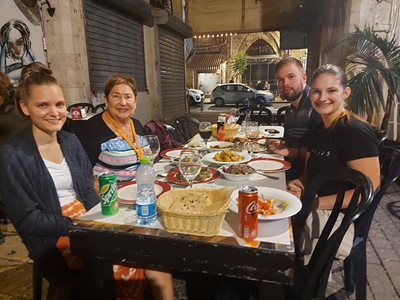
Walking along the shore of the Sea of Galilee after sundown, it occurred to me that this place, unfamiliar to me, is eminently familiar to Jesus.
I typically think of Jesus at the right hand of God, our crucified Saviour. I fail to think of Jesus as a human being with a life history located in a very specific place. Jesus had a hometown. The lapping of the Sea of Galilee, the moist air, the smell of fish, the scent of hyssop in cooked meat, the ripe figs littering the ground, the early, warm autumn nights – all these things were as familiar to Jesus as frigid Canadian winters are to us.
Since our tour guide was a secular Jew, the main Christian commentary was her Bible, dutifully opened to the relevant passage for each site. (For some mysterious reason, the Bible was handed straight to me each time, and I was told to read aloud!)
In the absence of detailed commentary from pastors or Christian experts, those read-aloud sessions shaped my own thoughts of places we visited along the shores of Galilee and the surrounding areas. Here are a handful of observations that seemed relevant to me:
Synagogue in Nazareth
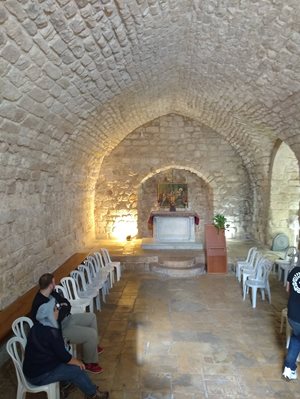
In Nazareth, now an Arab town, we visited a synagogue near the rumoured location of Joseph’s carpentry shop. While this specific synagogue was probably not the one where Jesus taught, it was similarly small, with only room for a few dozen people.
According to the Gospel of Luke, Jesus entered a synagogue in Nazareth and began reading Isaiah’s words about the year of the Lord’s favour. At first his audience in Nazareth was delighted and impressed by the eloquence of this young local man, who they knew as “Joseph’s son.” Then, abruptly, Jesus warned them, “No prophet is accepted in his hometown.”
By the standards of any modern Christian ministry, Jesus’ ministry was off to a flourishing start. He could have simply continued preaching from Isaiah, and the people of Nazareth would have probably welcomed his eloquence with open arms. But Jesus wasn’t interested in expanding his ministry as much as he was in revealing the condition of people’s hearts.
Mount Precipice

Luke continues, “They got up, drove him out of the town, and took him to the brow of the hill on which the town was built, in order to throw him off the cliff. But he walked right through the crowd and went on his way” (Luke 4:28-29).
Mount Precipice, just outside Nazareth, is believed to be the hill in Luke’s story. We drove up this mountain to a perfectly unobstructed view of the Valley of Jezreel (Megiddo), along with other mountains such as Mount Tabor (the Mount of Transfiguration).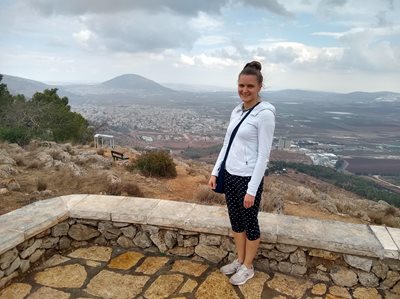
One can easily imagine that Jesus visited this mountain during His years growing up in Nazareth. But on that fateful day, Jesus was nearly thrown off the cliff by people who probably had known Him His whole life.
Capernaum
On another day, we visited the site of ancient Capernaum and the remnants of what is believed to be Peter’s mother-in-law’s house, where Jesus stayed. The house is also thought to be the place where the paralyzed man was lowered through the roof.
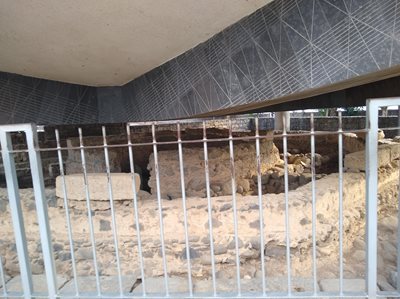
We could clearly see an original smaller house and then an expanded larger house encircling it. According to our guide, the home was expanded as more followers came to visit the site of Jesus’ miracles.
One might think people in Capernaum were more accepting of Jesus than in Nazareth. But Jesus declared, “And you, Capernaum, will you be lifted to the heavens? No, you will go down to Hades. For if the miracles that were performed in you had been performed in Sodom, it would have remained to this day” (Matthew 11:23).
Mount Hermon
In the middle of our week in Israel, we visited Banias at the foot of Mount Hermon, where a spring flows gently from the bedrock. The Greeks had built a sanctuary for the god Pan there, and niches for statues remain, carved with impressively intact detail in the tan-coloured rock. Birds soared overhead as we climbed around the remnants of the temple.
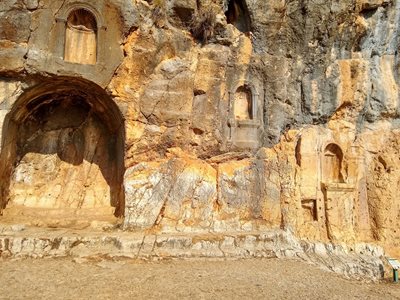
It would be hard to create a more lasting shrine than to literally carve it into a mountain. This sanctuary to Pan was the city shrine of Caesarea Philippi, where Jesus asked his disciples, “Who do you say I am?”
Simon Peter answered, “You are the Messiah, the Son of the living God.” (Matthew 16:15). Jesus declared, “And I tell you that you are Peter, and on this rock I will build my church, and the gates of Hades will not overcome it” (Matthew 16:18).
One of the members of our tour commented that he understood why Jesus made this statement right here, near the shrine to Pan. Jesus was predicting the church would be far more everlasting than the rocks whose pagan carvings endure thousands of years later.
Leaving Galilee
After we left Galilee, we journeyed to Jerusalem. Though Galilee and Nazareth have grown and developed since Jesus’ day, they still seem less significant than Jerusalem, site of the Temple Mount and crowds of religious pilgrims. In Jesus’ time, Nazareth was just a hamlet with an estimated population of 400.
Jesus’ own brothers told Him: “Leave Galilee and go to Judea, so that your disciples there may see the works you do. No one who wants to become a public figure acts in secret. Since you are doing these things, show yourself to the world” (John 7:3-5).
Garden Tomb
Ultimately, of course, Jesus did go to Jerusalem. On a sunny Sabbath morning, we visited the Garden Tomb, considered a possible site of Jesus’ burial. The site was likely a vineyard in the past; we saw a winepress, along with olive trees and other still-green trees along the stone walls. The tomb nearby was likely a family tomb, typical for wealthy individuals like Joseph of Arimathea.
.jpg?width=400&height=298)
That morning, the site was filled with crowds worshipping and pastors preaching. We rapidly entered and exited the tomb along with hundreds of others. The crowds made it hard for me to imagine the resurrection morning, when Peter and John ran by themselves to the tomb.
And yet, this is the legacy of the resurrection. The crowds of worshippers, from the Garden Tomb to the Church of the Holy Sepulchre nearby, and the groups walking the Via Dolorosa are reminders of how the gospel spread from the Holy Land to the whole world and now draws pilgrims back to Israel.
Boat on the Sea of Galilee
During our stay in Galilee, we had the privilege of riding in a replica of a 2,000-year-old fishing boat on the shores of the Sea of Galilee on a calm night. The Sea of Galilee is small, less than a tenth the size of Lake Ontario, and it was peaceful that night in the darkness.
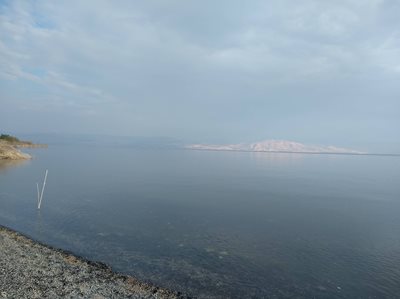
I could imagine Peter and the other disciples fishing all night, as they did one night after Jesus’ resurrection, hour after hour ticking by in the blackness, finding nothing.
But in the morning, Jesus, in His resurrected body, appeared and told them to cast their nets to the right side (John 21). Instantly, they had a netful of fish.
Later, Jesus asked Peter three times, “Do you love me?” Then He said to him, “Feed my sheep” (John 21:17).
I was only in Galilee for three days and Israel for a week, but during that time, I gained a paradoxical picture of Jesus’ ministry. He was widely recognized, yet He sought privacy as much as possible. He had many followers, yet many rejected Him, including people in His hometown and across the region where He lived. Despite all this, He built a church that became truly international. The worshippers in Jerusalem are only a fraction of the billions around the world who call him their Lord.
Rachel Baarda of Ottawa is distribution and circulation coordinator for Faith Today. This article is sponsored by Israel Tourism.
From top to bottom:
Photo 1: Al-fresco dining in Israel
Photo 2: Nazareth synagogue
Photo 3: Panoramic view from Mt. Precipice
Photo 4: Rachel in front of Mount Tabor (the Mount of Transfiguration)
Photo 5: Peter's mother-in-law's house at Capernaum
Photo 6: Niches carved into the mountain at the shrine to Pan at Mount Hermon
Photo 7: Visitors entering the Garden Tomb
Photo 8: Sea of Galilee across from the Golan Heights, where Jesus supposedly appeared to the disciples after his resurrection
Video 1: Climbing past the shrine to Pan at Banias (formerly the area of Caesarea Philippi)
Video 2: International visitors entering the Garden Tomb